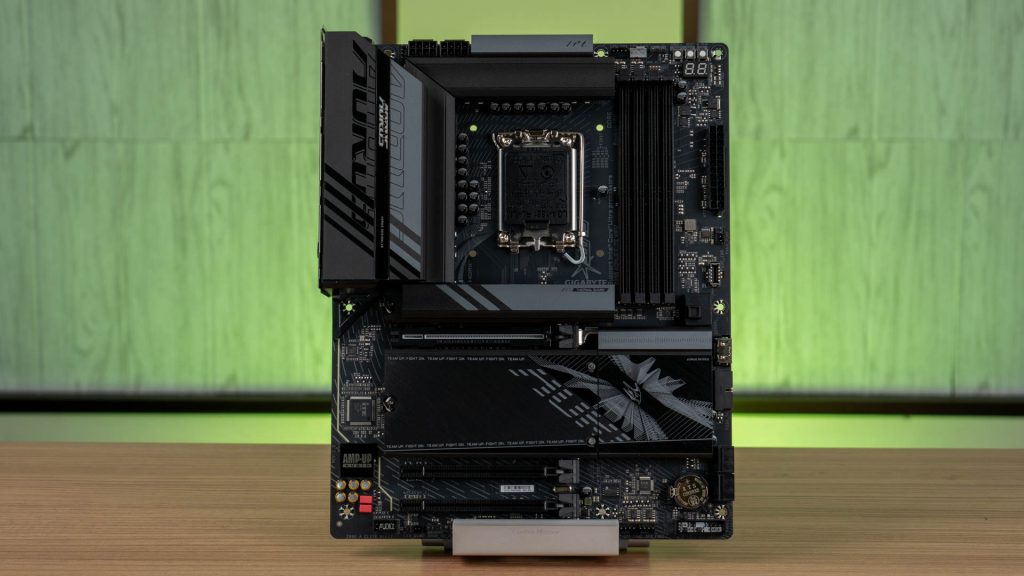Today, Intel launched its new desktop CPUs, the Core Ultra 200S series. These processors require the new LGA1851 socket, so compatible motherboards need to use Intel’s 800-series chipset. Gigabyte, one of Intel’s key partners, has also introduced a new lineup of Z890 chipset motherboards.
In this article, we’ll take a first look at one of the offerings from Gigabyte: the Z890 AORUS ELITE WIFI7. This board targets mainstream users who want to tweak and optimize their systems without the need for the more advanced designs found in enthusiast-level models like the AORUS Master or Xtreme. With significant updates to connectivity and memory support, we’re eager to see what Gigabyte has in store with this board – let’s dive in.
Unboxing
This slideshow requires JavaScript.
The packaging of the Z890 AORUS ELITE WIFI7 is reminiscent of the Z790 AORUS ELITE X WIFI7, featuring a similar overall design and layout that reflects Gigabyte’s branding. However, a closer look reveals that the AORUS logo on the front of the box has a slightly darker hue in this version, adding a subtle touch of sophistication.
On the back of the box, key features of the motherboard are clearly highlighted, providing an informative overview of its capabilities and components, making it easy for potential buyers to understand what this board has to offer.
 Unlike the enthusiast-grade boards like the AORUS Master or Xtreme, the accessories bundled with the Z890 AORUS ELITE WIFI7 are quite minimal—no frills, just the essentials needed to get started. One noteworthy inclusion is the Q-connector, which, while not something I use, can be very helpful for users who may be unfamiliar with the power and reset switches on the front of their PC case.
Unlike the enthusiast-grade boards like the AORUS Master or Xtreme, the accessories bundled with the Z890 AORUS ELITE WIFI7 are quite minimal—no frills, just the essentials needed to get started. One noteworthy inclusion is the Q-connector, which, while not something I use, can be very helpful for users who may be unfamiliar with the power and reset switches on the front of their PC case.
Additionally, the WiFi antenna features the EZ Plug connector, which enhances convenience and simplifies the installation process.
Design-wise, the Z890 AORUS ELITE WIFI7 closely resembles the X870E AORUS ELITE WIFI7 which we reviewed a few weeks ago in many aspects. When compared to its predecessor, the Z790 AORUS ELITE X WIFI7, several notable improvements can be seen that enhance user convenience.
These upgrades include the WiFi EZ-Plug, which streamlines the installation of the Wi-Fi antenna, and the improved M.2 EZ-Latch design, which simplifies SSD installation. Additionally, the PCIe EZ-Latch feature allows for easier graphics card removal by simply pressing a latch release button. These thoughtful enhancements aim to improve the overall building experience for both enthusiasts and casual builders alike.
This slideshow requires JavaScript.
Just like its X870E counterpart, it has a handful of upgrades on its QOL features, notably the main SSD heatsinks now utilize a click-lock latch design, which greatly simplifies the process of installing M.2 SSDs. Furthermore, the M.2 slots are clearly labeled for easy identification, enhancing the board’s user-friendliness. Another significant improvement is the addition of a PCIe latch release button, a feature that was previously found only on more premium AORUS motherboards.
These enhancements highlight AORUS’s commitment to making the AORUS Elite model more user-friendly and accessible. Such thoughtful design choices show a dedication to improving the overall building experience without sacrificing quality. These upgrades not only streamline the installation process but also demonstrate a clear understanding of the needs and preferences of contemporary PC builders.
This slideshow requires JavaScript.
The Z890 AORUS ELITE WIFI7 motherboard provides impressive memory support, making it an excellent choice for high-performance users. According to Intel, the new CPU supports 6400MT/s JEDEC kits right out of the box, but this motherboard can handle even higher speeds, with capabilities of up to 8800MHz through overclocking.
However, actual performance may vary depending on the specific memory modules and BIOS settings employed. In terms of memory capacity, the Z890 AORUS ELITE WIFI7 can support up to 256GB when all four DIMM slots are filled. This significant capacity is especially beneficial for users involved in demanding activities, such as content creation, gaming, or utilizing professional software, though it might not be the best setup for everyone. Overall, the motherboard’s memory features position it as a strong contender for anyone looking to build a powerful and future-proof system.
The MSI MAG Z890 TOMAHAWK WIFI offers an extensive range of I/O ports to meet a variety of connectivity needs, making it versatile for modern setups. It includes useful features such as BIOS Flashback for simple BIOS updates and a Clear CMOS button, which allows users to reset the BIOS with ease, particularly beneficial for troubleshooting or system tweaks.
In terms of networking, the board supports both 2.5G Ethernet and Wi-Fi 7, providing users with fast and stable internet connections. However, one thing to note is that the specific Wi-Fi 7 chip may vary depending on the PCB revision of the motherboard. Revision 1.0 of the board uses the MediaTek MT7925 Wi-Fi chip, while revision 1.1 uses the Realtek RTL8922AE chip, so it’s essential for users to check their motherboard version if this distinction matters to their setup.
As for the USB options, the motherboard provides a variety of ports: 4 x USB 2.0 ports, 3 x USB 3.2 Gen1 ports, 2 x USB 3.2 Gen2 ports, and a Thunderbolt 4 Type-C port. While these offer sufficient connectivity, the layout and quantity of USB ports might feel a bit limited for some users, and the overall arrangement could be more aesthetically pleasing. This could affect the overall convenience, especially for those with numerous peripheral devices.
First Impression
That wraps up our initial look at the Z890 AORUS ELITE WIFI7. As the performance test results are still under embargo, it will be some time before we can fully evaluate what the board is capable of through further testing. Based on this first impression of its design and features, Gigabyte has done a commendable job with this motherboard. However, there’s room for improvement, particularly in the finer details, such as the placement of ports and connectors throughout the board. Stay tuned for the performance review, which will be coming in a couple of weeks!










